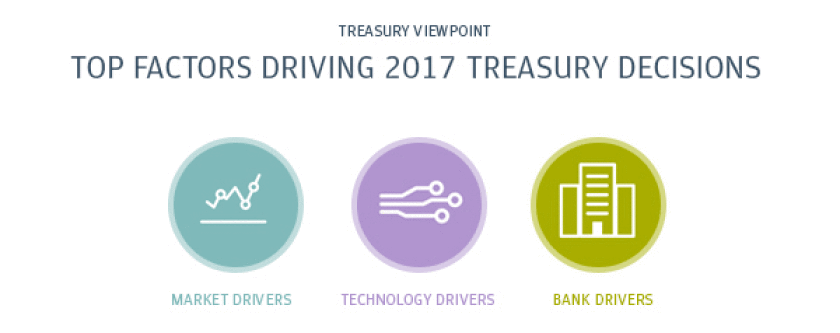|
 |
1. Political waves: The shifting political landscape around the world will impact economics, tax and trade. In 2017, the effects of the UK’s vote to exit the EU and Donald Trump’s victory in the US presidential election will intensify as elections take place throughout the year in more than 30 countries. Treasury will need to stay abreast of policies and evaluate how to adjust processes, structures and locations.
2. Currency volatility: The continued strength of the US dollar will maintain pressure on treasury to review where funds are held and deployed, as well as manage surplus cash. An integrated approach for liquidity management, FX controls and payments execution will be even more critical. Being strategic about bank account rationalization, cash concentration through pooling structures, natural hedging opportunities and new sweeping products will help re-engineer balance sheets and direct funds where needed.
3. Rate rises: While the Bank of Japan, the European Central bank and several other European authorities dropped interest rates below zero last year, the US Federal Reserve – after much anticipation – raised its benchmark rate incrementally in December. When doing so, the Fed announced additional rate hikes in 2017, indicating confidence in the US economy. Treasury will need to proactively manage capital structure and allocation strategies accordingly.
4. Cyber threats: As cyber attacks continue to increase in frequency and sophistication, collective responsibility will be essential. Treasury will need to collaborate across the organization to mitigate immediate risk (running daily operations efficiently and safely), while still building for future growth (product innovation and delivery). Technology and operations partners are natural allies, while AML, legal/compliance, client service and implementation teams can add tremendous value.
 |
5. Increased digitization: The introduction of new and disruptive technology will continue to deliver benefits to treasury. The digitization movement is concentrated in automating processes that will enable treasury to do more with less and direct resources to more strategic initiatives. The opportunities range from the digitization of new-account documentation to even faster B2B and B2C electronic payments. Keep a watch on how robotics, blockchain, API and cloud technology will be leveraged to drive operational and cost efficiencies, connectivity, transparency, speed, security and standardization.
6. Big data and actionable insights: Tied to increased digitization, treasury will have greater and timelier access to vast quantities of data and, more importantly, a deeper understanding of what that data means. One example is moving forecasting to a real-time basis as 'track and trace' will expand visibility of payments and collections. In cards, mining spend data may generate insights to develop compelling offers for cardholders that will increase loyalty and revenues.
 |
7. Bank relationships: Whether evolving regulation, some other external factor, or an organizational re-prioritization is behind a change in strategic direction, 2017 will most likely see more shifts among global and regional banks. Due diligence in evaluating banking relationships will be important for treasury to ensure there is a match in the short and long term. Part of deciding when it makes sense to switch banks is assessing which ones are acting as mere transaction providers rather than as strategic partners to help navigate challenges and opportunities.
8. Ease of doing business: To combat the commoditization of treasury products, banks will seek to differentiate from competitors via superior client service and implementation. Whether it’s retooling their own infrastructure to accommodate their clients, simplifying existing processes or delivering new channels, banks will focus on increasing the value of each client interaction.
Tips for treasury
✓ Do more with less – simplify complexity. Take an 'inside-out' approach by rationalizing and streamlining systems within organizations (TMS, ERP, people, processes, policies, locations, SSC, regional vs. centralized treasury) before turning to connectivity with external partners.
✓ Structure for agility – be flexible in order to adapt with minimal time and cost. Consider virtual accounting, Pobo/Robo structures or other centralized models to optimize cash flows.
✓ Select partners with care – prioritize those who have been investing strategically for the long term in key areas. Shortlist banks that collaborate closely with clients when developing solutions.
 |
